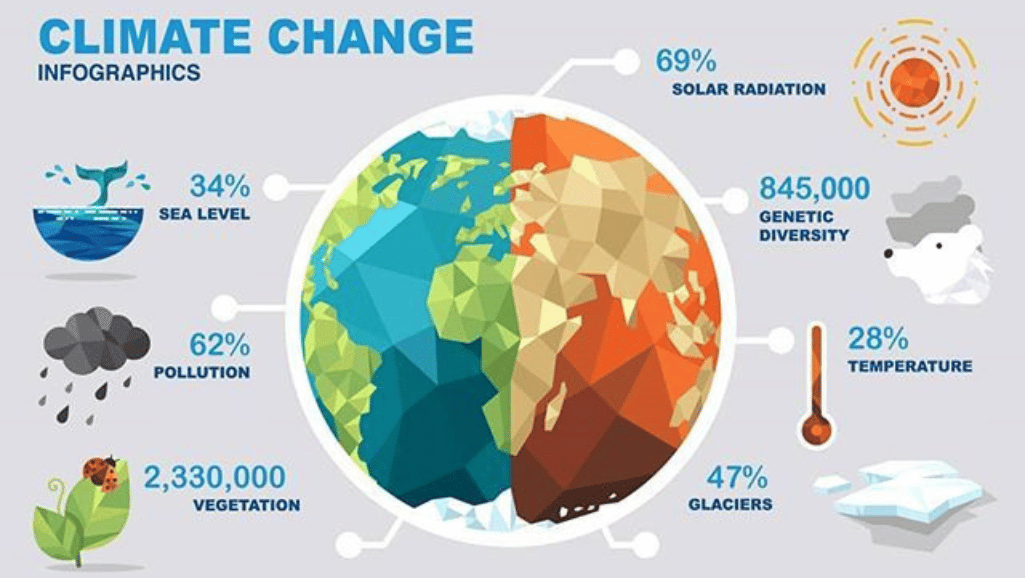
Beautiful flowers gardenia Plants For Your homes

Temperate climate zones have a special balance of weather. They have moderate temperatures and clear seasonal changes. These areas are between the Tropic of Cancer and Tropic of Capricorn. They have a wide range of temperatures and rainfall, perfect for many ecosystems and people.
Temperate regions across continents show off the beauty of changing seasons. You can see the vibrant colors of autumn and the fresh blooms of spring. Temperatures here are between zero and 20°C, sometimes going as low as -40°C or as high as +40°C.
This temperature range lets many plants and animals live and adapt. They change with the weather all year.
In temperate zones, rainfall varies a lot, from 300 to 2000 mm a year, with an average of 800 mm. This rainfall distribution is key to the landscape and supports many plants and animals. From North America’s lush forests to Europe’s rolling grasslands, these climates create many different habitats.
The temperate climate covers the middle latitudes of Earth, between 23.5° and 66.5° north and south of the equator. It has moderate temperatures, clear seasonal changes, and varied precipitation. This makes it interesting for those who study weather and climate.
A temperate climate, as defined by the Köppen climate classification, has a mean temperature below 18°C (64.4°F) in the coldest month. It also means the coldest month’s temperature is above −3°C (26.6°F). This covers a wide range of weather, from mild and humid in subtropical areas to extreme seasonal changes in continental climates.
This climate type has subcategories like the Mediterranean, oceanic, and continental climates. Each has its own weather patterns and where it can be found. For example, the Mediterranean climate has dry summers and wet winters, while the oceanic climate has mild summers and cool winters with steady rain all year.
Temperate climates are known for having four clear seasons: spring, summer, autumn, and winter. These seasons come from the Earth’s tilt and orbit around the sun. This tilt changes the amount of sun’s radiation received throughout the year, unlike the steady weather in tropical areas.
Precipitation in these regions changes a lot, based on latitude, elevation, and closeness to water or mountains. Some places get a lot of rain all year, while others have wet and dry seasons. For example, humid subtropical climates have long, hot summers and mild winters, while humid continental climates have very cold winters and hot summers.
Latitude and elevation also affect the temperature and weather in these areas. Generally, temperatures drop as you go further north or up higher. This is seen in subpolar oceanic climates, which have milder winters than subarctic climates because they’re closer to the ocean. Boreal or subpolar climates, found in high places and near the poles, have very cold winters and short, mild summers.
To learn more about temperate climates, check out this lesson. It’s great for both kids and adults.
Temperate zones cover a big part of the Earth, between the Tropic of Cancer and the Tropic of Capricorn. They make up 51.98% of the planet’s surface. The North and South Temperate Zones each take up 25.99% of the Earth.
These zones are found in different parts of the world. They have unique features and weather in the Northern and Southern Hemispheres.
In the Northern Hemisphere, temperate zones cover North America, Europe, and Asia. The U.S. and most of Canada are in the North Temperate Zone. They have different climates because of their location, height, and closeness to water.
Europe has many kinds of landscapes and weather. From the mild coast of the British Isles to the drier center and east. Central Asia, with countries like Kazakhstan and Mongolia, has vast grasslands and dry areas.
The North Temperate Zone is huge, covering 25.99% of the Earth. It has everything from green forests in eastern North America to the wide steppes of Eurasia. The temperate zones in the North support a lot of different plants and animals. They are used to the changing seasons and local conditions.
| Region | Percentage of Earth’s Surface | Key Areas |
|---|---|---|
| North Temperate Zone | 25.99% | Continental U.S., Canada, Europe, Central Asia |
| South Temperate Zone | 25.99% | Southern South America, Southern Australia, New Zealand |
In the Southern Hemisphere, temperate zones are in southern South America, southern Australia, and New Zealand. These places have their own weather and plants and animals. Southern South America has different climates, from Mediterranean-like in central Chile to the cool, wet Patagonia.
Southern Australia and New Zealand are also in the South Temperate Zone. Australia has temperate grasslands and dry areas. New Zealand has green rainforests and mountains.
The South Temperate Zone also covers 25.99% of the Earth. It’s known for its unique plants and animals. These areas are important for the health of the planet and the variety of life they support.
Temperate climates have four seasons: spring, summer, autumn, and winter. Each season changes the temperature, how much it rains, and daylight hours. This makes each year different and exciting.
The Earth’s tilt affects how the sun’s energy reaches the planet. This tilt causes the seasons to change. In summer, the sun’s rays hit the Earth straight on, making days longer and warmer. In winter, the rays hit at an angle, making days shorter and colder.
How much it rains also changes with the seasons. Spring and autumn get moderate rain. Summer might have storms or be very dry, depending on where you are. Winter brings snow in cold places and rain and snow in milder areas.
| Season | Temperature Changes | Precipitation Patterns |
|---|---|---|
| Spring | Gradual warming | Moderate rainfall |
| Summer | Warmest temperatures | Thunderstorms or dry spells |
| Autumn | Gradual cooling | Moderate rainfall |
| Winter | Coldest temperatures | Snow or a mix of rain and snow |
Seasons deeply affect the natural world. Plants and animals adjust to these changes. Deciduous trees lose their leaves in autumn and sleep through winter. Many animals move or sleep through the cold months.
Humans also change their ways with the seasons. Farmers and energy users plan for the changes. Knowing about the seasons helps us understand the weather, use resources wisely, and plan our lives.
Learning about temperate climates’ seasons helps us enjoy and adapt to their beauty. It teaches us to appreciate the unique qualities of each season. This way, we can live in harmony with nature’s changes.
Temperate climates have moderate temperatures and balanced weather all year. They are found in places like the United States, Canada, Australia, New Zealand, Japan, and parts of Europe. These climates support a wide variety of plants and animals, making them perfect for many species.
In places like Britain, the sea helps control the weather. It keeps the land cooler in summer and warmer in winter. This is because water takes longer to heat up or cool down than land. So, maritime temperate climates don’t have big changes in temperature throughout the year.
Temperate climates have temperatures between 10 to 25 degrees Celsius (50-77 degrees Fahrenheit). These mild temperatures support many plant types, like forests, grasslands, and shrublands. They also home a wide variety of animals, depending on the area and habitat.
Temperate areas get between 300 to 2000 mm of rain a year, averaging about 800 mm. This rain is key for the ecosystems and farming in these areas. In places like Britain, storms from the North Atlantic bring rain and moisture all year. This keeps the land green and supports farming.
| Region | Average Annual Precipitation (mm) |
|---|---|
| Temperate Climates (Overall) | 300-2000 |
| Maritime Temperate Climates | 800-1200 |
| Continental Temperate Climates | 500-1000 |
Rainfall in temperate climates shapes the landscape and affects farming. Lowlands in these areas are warm, get steady rain, and are great for big farms. They have rich soil and a long growing season, perfect for growing crops like wheat, corn, and soybeans.
Within the temperate climate zone, there are several distinct climate types. These variations are influenced by factors like proximity to large bodies of water, elevation, and latitude. Knowing the different types of temperate climates is key for many areas, including agriculture, urban planning, and ecosystem management. Climate zones are set by temperature, precipitation, and geographical location.
Mediterranean climates are found near the Mediterranean Sea and in parts of California, Chile, South Africa, and Australia. They have dry summers and mild, wet winters. These areas get long, warm summers with little rain and short, cool, rainy winters.
The average annual rainfall is between 15 to 40 inches, with most rain in the winter.
Oceanic climates, also known as marine west coast climates, are in coastal areas between 40 and 55 degrees latitude. They have mild temperatures and high humidity all year, with rain spread out over all seasons. The ocean nearby helps keep temperatures steady, making these climates cooler.
Places with oceanic climates, like the Pacific Northwest and Western Europe, have cool summers and mild winters. They get about 30 to 60 inches of rain a year.
Continental climates are in the middle of continents, away from the ocean’s moderating effect. These areas see big temperature changes, with cold winters and warm summers. They can be humid continental or subarctic.
Humid continental climates have cold winters and warm to hot summers. Subarctic climates are even colder, with short, cool summers. Rainfall varies by location but is usually 15 to 45 inches a year.
| Climate Type | Temperature Range | Precipitation |
|---|---|---|
| Mediterranean | Warm, dry summers; mild, wet winters | 15-40 inches annually, mostly in winter |
| Oceanic | Cool summers; mild winters | 30-60 inches annually, evenly distributed |
| Continental (Humid) | Cold winters; warm to hot summers | 15-45 inches annually |
| Continental (Subarctic) | Extremely cold winters; short, cool summers | 15-45 inches annually |
Understanding the different temperate climates helps us see how they affect ecosystems and human activities. This knowledge is key for sustainable practices and dealing with climate change in temperate regions worldwide.
Temperate regions have balanced weather that supports a wide variety of plants. The temperatures are moderate, and rainfall is evenly spread, making it perfect for many plants to grow. These include deciduous forests, grasslands, and prairies. These ecosystems are not just beautiful but also crucial for the economy and nature of these areas.
Deciduous forests are a key feature of temperate zones. They are mainly in the Northern Hemisphere, like Eastern Asia, Central and Western Europe, and the Eastern United States. These forests are famous for their colorful fall leaves, which they drop in the cold winter months. They are full of life, with many plants and animals, such as deer, bears, and birds.
In the mountains of temperate regions, deciduous trees change to coniferous trees. These trees are better suited for the cold and short growing seasons in these areas.
Grasslands and prairies are big parts of temperate vegetation. They are filled with grasses and plants, with few trees. These areas, like the North American prairies or the Eurasian steppes, have rich soil and lots of wildlife. They are also key for farming, growing crops like wheat, barley, and oats.
Temperate grasslands often have woodlands too, making a mix of habitats. This supports a wide variety of species.
Temperate regions also have microclimates, which are small areas with their own climate. These can be due to the land’s shape, being near water, or the types of plants there. These microclimates help certain plants grow, adding to the diversity of temperate ecosystems. From the colorful deciduous forests in fall to the wide grasslands, temperate regions show how climate and life work together.




